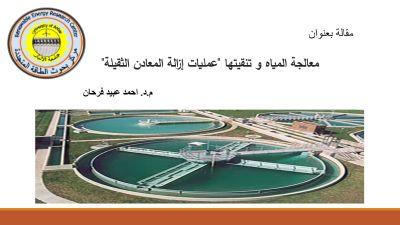| News Details |
Water treatment and purification "Heavy metal removal operations"
2022-05-08

Dr. Ahmed Obeed Farhan
The term heavy metal refers to any metallic chemical element with a relatively high density and non-toxic or toxic at low concentrations. Examples of heavy metals include mercury, cadmium, arsenic, chromium, thallium, and lead.
Heavy metals are natural elements of the earth's crust. They cannot be decomposed or broken down to a small degree. They enter our bodies through drinking water, food and air. As trace elements, some heavy metals (such as copper, selenium, and zinc) are necessary to maintain the human body’s metabolism. However, at higher concentrations, they can lead to poisoning. Heavy metal poisoning can result, for example, from contaminated drinking water (eg lead pipes), elevated ambient air concentrations near emissions sources, or intake through the food chain.
Heavy metals are dangerous because they tend to bioaccumulate. Accumulation means an increase in the concentration of a chemical in a biological organism over time, compared to the concentration of a chemical in the environment. Compounds accumulate in living organisms any time they are taken up and stored fadster than they are broken down (metabolized) or excreted.
Heavy metals can enter the water supply from industrial and consumer waste, or even from acid rain from the soil and the release of heavy metals into streams, lakes, rivers, and groundwater.
Environmental and health risks.
Now we are going to describe the effects of heavy metals on the environment. The three most pollutants are heavy metals lead, cadmium, and mercury.
Effects of antimony on the environment
Antimony is a metal that is used in the compound of antimony trioxide, a flame retardant. It can also be found in batteries, coloured materials, ceramics and glass. Exposure to high levels of antimony for short periods causes nausea, vomiting, and diarrhoea. There is little information about the effects of long-term exposure to antimony, but it is suspected to be a carcinogen. Most antimony compounds do not accumulate in aquatic life.
Effects of cadmium on the environment
Cadmium derives its chemical toxicological properties from its similarity to zinc, an essential micronutrient for plants, animals, and humans. Cadmium is a vital persistence and, once absorbed by a living organism, remains a resident for many years (over decades for humans) although it eventually presents.
In humans, prolonged exposure leads to kidney failure Long exposure leads to obstructive pulmonary disease and has been linked to lung cancer, although data on it is difficult to explain because compound factors may also lead to bone defects (osteomalacia, osteoporosis) in humans and animals. In addition, the mineral can be linked to an increase in blood pressure and its effect on the heart muscle in animals, although the data obtained do not support these findings.









